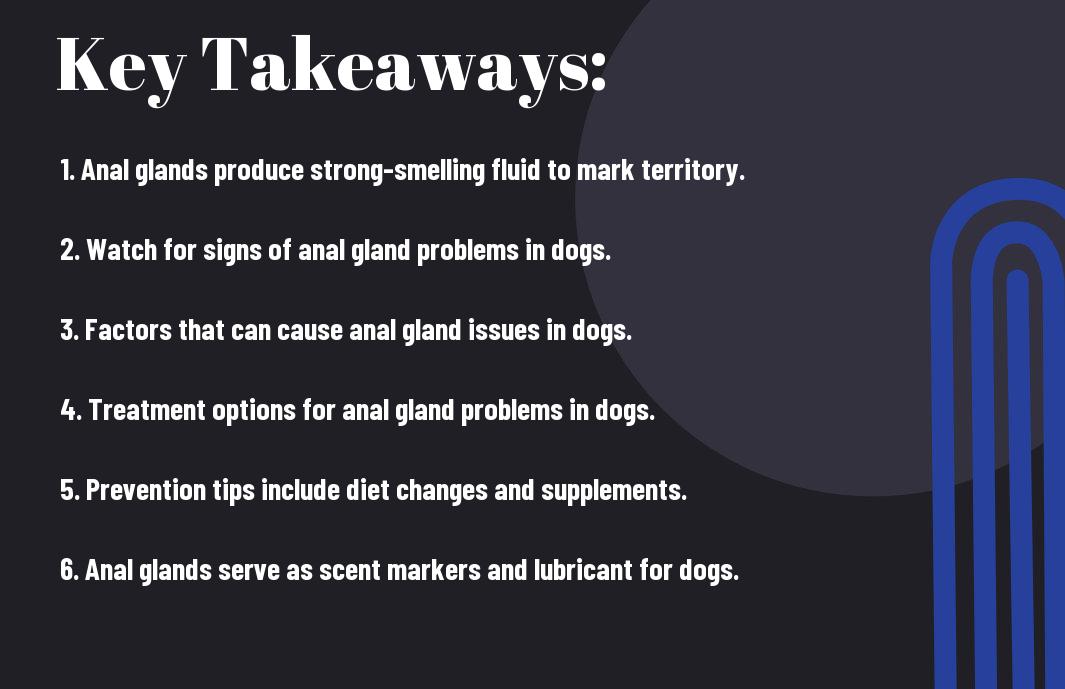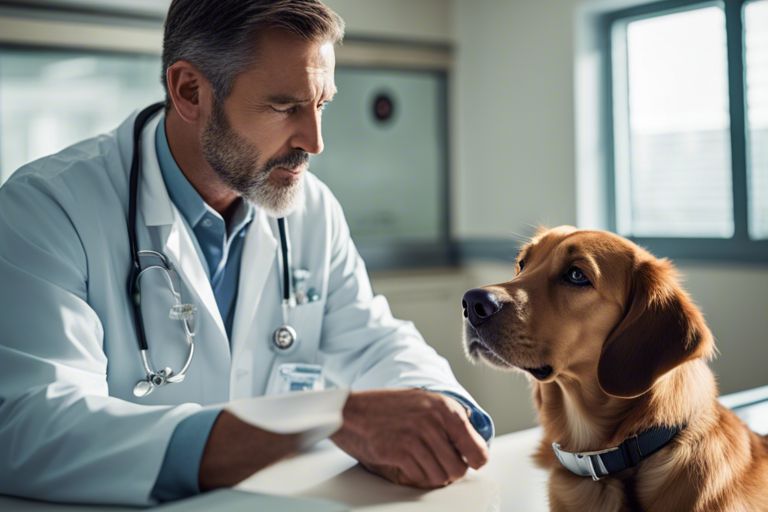With dogs’ anal glands being a mysterious and sometimes smelly topic for pet owners, understanding their purpose and potential problems is crucial for canine health. Here are valuable insights and expert advice on how to navigate through anal sac issues in dogs. From causes and symptoms to treatment and prevention, this comprehensive guide will shed light on anal gland care, ensuring your furry friend stays happy and healthy. Whether you’re a seasoned dog owner or a novice, this informative resource will help demystify anal gland issues in dogs and empower you to take proactive steps for your pet’s well-being.
Key Takeaways:
- Anal Gland Function: Dogs have anal glands that produce a strong-smelling fluid for marking territory or helping with bowel movements.
- Signs of Issues: Watch out for signs like scooting, licking, straining, or presence of blood in stool to detect anal gland problems in your dog.
- Treatment and Prevention: If your dog experiences anal gland issues, seek veterinary assistance for manual expression and dietary adjustments to prevent further complications.
Signs of Anal Gland Problems in Dogs
To understand the signs of anal gland problems in dogs, refer to the comprehensive guide on Anal Glands in Dogs: Everything You Need to Know. These signs can indicate underlying issues that require attention from a veterinarian.
Scooting and Licking
The most common signs of anal gland problems in dogs include scooting the rear end along the floor or lawn and excessive licking or itching in the anal area. These behaviors are often the dog’s attempt to alleviate discomfort caused by anal gland issues.
Foul Odor
Anal gland problems can also manifest as a foul odor emanating from your dog. This odor may be particularly pungent and fishy, indicating an issue with the anal glands. If you notice this smell, it’s vital to address it promptly to prevent further complications.
Licking the anal area as well as the presence of a foul odor could be signs of anal gland problems in dogs. It’s important to monitor your dog’s behavior and seek veterinary assistance if these symptoms persist.
Visible Swelling
In some cases, anal gland problems may result in visible swelling near the anal area. This swelling can indicate an underlying issue with the anal glands that requires professional attention. It’s crucial to consult with your veterinarian if you notice any signs of swelling in your dog’s anal region.
Licking or discomfort around the anal area can be indicative of visible swelling caused by anal gland problems in dogs. Prompt veterinary intervention is recommended to address any potential issues and ensure your dog’s well-being.
Causes of Anal Gland Problems in Dogs
Dietary Issues
Any imbalance in your dog’s diet can lead to anal gland problems. Insufficient dietary fiber can cause the glands to become impacted, leading to discomfort and potential infection. Including supplements like fish oil and canned pure pumpkin can help regulate your dog’s digestive system and prevent anal gland issues.
Obesity and Inactivity
Inactivity and obesity are also common factors contributing to anal gland problems in dogs. Dogs that lead a sedentary lifestyle are more prone to developing anal gland issues, as lack of exercise can lead to digestive problems and constipation. Research shows that obesity is linked to anal gland problems, as excess weight can put pressure on the glands, leading to impaction and infection.
Issues related to obesity and inactivity are significant contributors to anal gland problems in dogs. It’s important to ensure your furry friend is getting enough exercise and maintaining a healthy weight to prevent these issues from occurring. Be mindful of, a balanced diet and regular physical activity are vital for your dog’s overall health and well-being.
Treatment and Prevention of Anal Glands Disease
Despite the discomfort they can cause, anal gland issues are common in dogs and require prompt attention. If your dog is displaying signs of anal gland problems, it is important to seek the advice of a veterinarian. Your veterinarian may manually express the sacs or prescribe antibiotics or supplements if an infection is present. For more information on disorders of the rectum and anus in dogs, visit Disorders of the Rectum and Anus in Dogs – Dog Owners.
Professional Medical Interventions
Professional intervention by a veterinarian is vital when dealing with anal gland issues in dogs. Your veterinarian may manually express the anal sacs to provide relief and treat any infections present. It is important to follow your vet’s recommendations and schedule any follow-up appointments as needed to monitor your dog’s condition and ensure proper healing.
Home Care and Maintenance
Home care and maintenance play a crucial role in preventing and managing anal gland problems in dogs. Regularly monitoring your dog’s anal area for signs of irritation or discomfort, maintaining a balanced diet high in fiber, and ensuring your dog gets enough exercise can help prevent issues with anal glands. In some cases, adding supplements like fish oil or canned pumpkin to your dog’s diet may also be beneficial in promoting healthy anal gland function.
What is the Purpose of a Dog’s Anal Sac?
Unlike the visible and often charming behaviors dogs exhibit, the purpose of a dog’s anal sac is a bit less glamorous. Dr. Karen Becker | Anal Gland Problems in Dogs 🐕⬅️ One… here suggests that a dog’s anal sacs, also known as anal glands, play a crucial role in scent communication and natural lubrication during defecation.
Natural Lubrication During Defecation
On a biological level, the excretion from a dog’s anal gland serves as a natural lubricant to facilitate the passage of hard stool during defecation. This lubrication aids in the smooth and pain-free elimination of waste from your dog’s body.
Scent Communication
Lubrication produced by a dog’s anal gland is not the only purpose it serves. Scent communication is another critical function of these sacs. The excretion from the anal gland contains a unique scent that identifies the dog to other canines, conveying information such as the dog’s sex, health status, and approximate age.
Purpose.
Conclusion
With this in mind, it is crucial for dog owners to be aware of the potential issues that can arise with their pet’s anal glands. Understanding the signs and causes of anal gland problems, as well as the importance of proper treatment and prevention, can help ensure the health and well-being of our furry friends. By staying informed and proactive, dog owners can work with their veterinarians to address any anal gland issues that may arise, ultimately leading to a happier and healthier life for their beloved canine companions.
FAQ
Q: What are anal glands in dogs?
A: Anal glands are small oval-shaped sacs located on either side of a dog’s anus. They produce a fluid with a strong, pungent odor unique to each dog.
Q: Why do dogs express their anal glands?
A: Dogs may involuntarily express their anal glands when they are fearful, stressed, or marking territory. It is a natural behavior for dogs.
Q: What are the signs of anal gland problems in dogs?
A: Signs of anal gland issues in dogs may include scooting the rear end along the floor, excessive licking or itching of the anal area, straining during bowel movements, and blood or pus in the stool or near the rectum.
Q: What causes anal gland problems in dogs?
A: Factors that may contribute to anal gland problems in dogs include chronic skin dermatitis, obesity, insufficient dietary fiber, chronic soft stool, food and/or environmental allergies, and genetics. These factors can lead to impacted, infected, or abscessed anal glands.
Q: How can anal gland problems be treated and prevented?
A: Treatment for anal gland issues may involve manual expression of the sacs by a veterinarian, prescription of antibiotics or supplements for infections, and dietary adjustments with increased fiber and fish oil. Preventative measures can include a balanced diet, regular exercise, and consulting with a veterinarian for recommendations specific to your dog’s needs.
Are strawberries toxic for dogs




